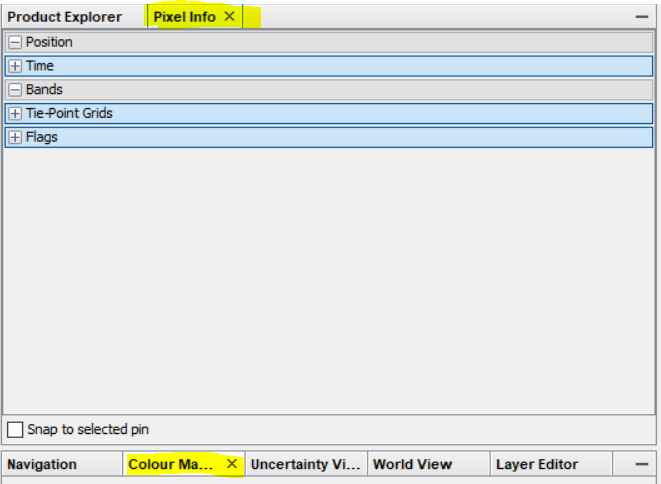Dear all,
I processed Sentinel data, using ESD for the Ridgecrest earthquake, but I still see the deburst issue in my interferogram. i appreciate if you could help me to solve this issue.
Best,
Mozhdeh
After Deburting:
Before Debursting:
Dear all,
I processed Sentinel data, using ESD for the Ridgecrest earthquake, but I still see the deburst issue in my interferogram. i appreciate if you could help me to solve this issue.
Best,
Mozhdeh
After Deburting:
Before Debursting:
Would you please to share the steps you followed, to be able assist you,
Which DEM did you select in the step of back-geocoding?
Did you alter any of ESD? Or Did you applied the default?
Dear [falahfakhri]
Thanks for your reply. I used SLC type data and applied default on ESD. The steps were: Read> S1 TOPS coregistration> ESD > Interferogram formation> Debursting
(but it doesn’t seem to be debursted?!)
After that i applied: Multilooking > Filtering (goldstein) > Unwrapping
and this is the result:
I didn’t do the displacement and geocoding since i found the result like that.
Please take a look at the ProcessingSteps To create SingleInterferogram in the following post,
Be advised to select SRTM 1sec DEM, in the step of Backgeocoding
In case still gap case, alret the ESD parameters:
Search Windows Accuracy in Azimuth direction to 32
Search Windows Accuracy in range direction to 32
Windows overlapping factor to 256,
But first apply the default with the aforementioned steps.
these patterns come after the unwrapping - please make sure to include enough tile overlapin the configuration of snaphu: SNAPHU parameters
But , here according to the first post, the gap mis-corregisted already existed in wrapped phase,
Thanks a lot for your help. I did the steps again like what you told me. it looks better but still there is a very sharp line on the upper part of the image, but it doesn’t seem to have jumps. I also applied the multilooking and filtering(goldstein) but not unwrapping.
Is this the result of default ESDs’ parameters?
Or , the modified one, were mentioned in the aforementioned post!
How many bursts are they?
Would you please to share the screenshot of two images after DEBURST, before infgm creation
There are phase discontinuities between the Sentinel-1 TOPS bursts for large earthquakes that have significant motion in the north-south direction. This is not an error in the processing but is caused by the along-track component of motion and the different look direction in the two bursts due to the TOPS mode.
The ESD calculation cannot remove these discontinuities because they vary over the scene.
Yes, many of the errors in the unwrapped phase are likely due to lack of overlap between the tiles, but this earthquake is very hard to unwrap correctly due to the large displacement and high coherence up to the fault ruptures. We had to apply manual masks of the faults to unwrap the Sentinel-1 interferograms correctly when we processed this earthquake with ISCE. I don’t know if that is possible in SNAP.
Thanks a lot Eric for this clarification, but would please to mention the location, time-date and the magnitude of this earthquake,
There were two large earthquakes near the town of Ridgecrest, California that are included in this interferogram. One was on 4 July magnitude 6.4 and the other was on 5 July (6 July UTC) magnitude 7.1. Note that there were two Sentinel-1 passes over Ridgecrest along tracks 64 and 71 on 4 July, but they were both before the M6.4 earthquake. The faults from the M6.4 and M7.1 earthquakes intersect, which is probably the main reason that phase unwrapping is difficult. The M6.4 Geographic coordinates: 35.643N, 117.564W. The M7.1 Geographic coordinates: 35.767N, 117.605W. These are the initial epicenters that were revised later.
See our paper published on 17 October:
Ross, Z. E., et al. (2019), Hierarchical interlocked orthogonal faulting in the 2019 Ridgecrest earthquake sequence, Science , 366 (6463), 346-351, doi:10.1126/science.aaz0109.
Excuse me, I want to ask something. I used a graphbuilder. Inside it there are back-geocoding, enchanced spectral-diversity, interferogram, and topsar deburst. But there’s no picture display on the result, I mean the phase, coh, and others that include in bands are blank. What’s the problem? Thank you so much.
Creating Single Interferogram
Also please have a look and you could also use this Processing Steps of Creating Single Interferogram In case you are applying the processes through out gpt
And how about ways to look at the coherence value?
My problem was solved. It’s because I had to update the SNAP to the newer version and also download the plugins. Thanks for your explanation.
Please use PixelInfo tab to identify the single point coherence also ColourManipulation to identify the range of coherence.
